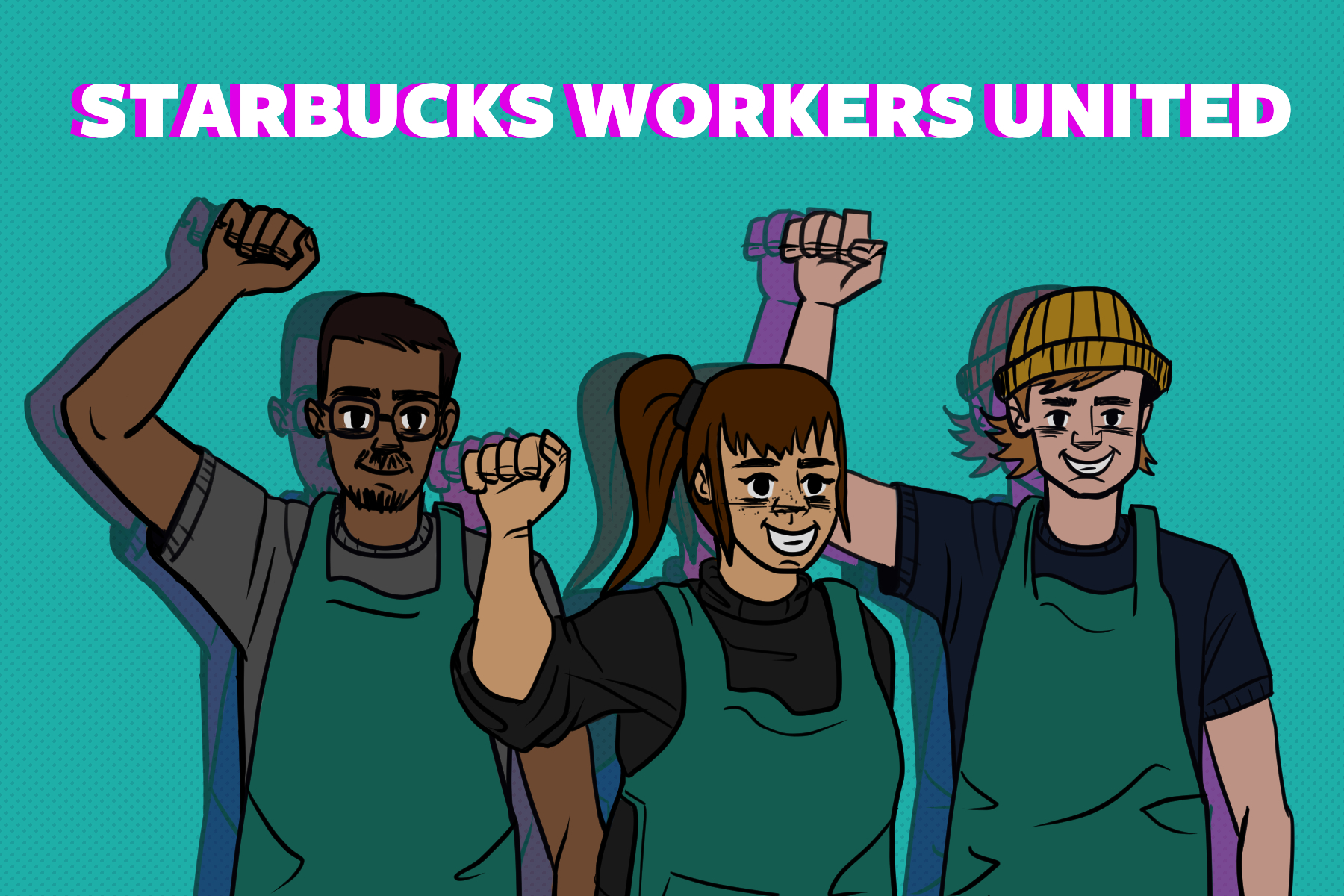The state of organized labor in the United States is relatively grim, following decades of political disinvestment in union strength. The middle of the 20th century saw workers across numerous industries affiliate with one another to ensure optimal employment conditions; however, changing fiscal attitudes prompted union-busting to come into vogue. Corporations are unable to ban unions or fire employees planning to organize one, yet their messaging to employees compounded by general social attitudes toward unions has resulted in a nation of largely individualized labor participation. Only 14 million workers were active members of a union in 2021, a mere 10.3% of the nation’s workforce. Despite the presently weakened status of organized labor, one union, Starbucks Workers United, has achieved several recent successes that may represent a forthcoming wave of labor mobilization.
Starbucks Workers United is a fitting title for the union of baristas at the multinational coffee chain, and although its name has since become the foremost symbol of triumph within activist circles, it came from quite humble beginnings. Michelle Eisen is a theater artist and longtime barista who started Starbucks Workers United at a Buffalo, New York, location in 2021. Her rationale for entering the murky world of labor activism was simple: the grueling labor conditions of her workplace. “I was watching my coworkers struggle to pay their rent and put groceries in their fridge while working a full-time job,” Eisen stated in an interview with Bloomberg. “I’m certainly fighting this for myself, but I’m also fighting it for my coworkers and for future workers in the service industry.” Eisen worked to bring the union to life in the Buffalo area, working with her coworkers to push for better working conditions following the strenuous circumstances of working at Starbucks during the pandemic. Since the first election to unionize in Buffalo, 168 other stores have successfully organized across 30 states, with many other locations scheduled to hold elections within the coming weeks.
Starbucks Workers United is novel for achieving considerable success within a rigid corporate environment, but it is operating within a decades-old procedural framework that all strong unions have employed. Employees who desire to form a union generally initiate the formation by discussing their desired outcomes with a business’s entire employee base before taking an official vote on unionizing. Once a union is voted into existence, the National Labor Relations Board certifies the organization and the union can then engage in collective bargaining with the company’s executives, wherein both parties draw up a contract for the business’s practices. The contracts that individual stores formulate will vary considerably given the unique circumstances of each location, but the union’s official media offers a good look at the general agenda.
The union’s website provides a comprehensive outline of the organization’s goals and operational framework, particularly highlighting the power of collective bargaining. The frequently asked questions page states: “We will have the right to negotiate a union contract and have a real voice in setting organization policies, rights on the job, health and safety conditions, protections from unfair firings or unfair discipline, seniority rights, leaves of absence rights, benefits, wages, etc.” The goals are largely in line with Eisen’s stated goals and comprise a list of material changes that would empower Starbucks employees to have greater ownership of their labor. The language the website employs does not distinguish between manager and barista, and the plural first-person “we” seemingly includes all who are employed within a given store regardless of seniority. The demands are thus leveled mostly at the corporate executives who have the power to enact change in the company’s current structure, for these are often the people that are most resistant to change.
Corporations wield an immense amount of power when confronted with unionization, but sometimes take a soft approach toward dismantling the organization due to legal precedent or concerns about their public image. In response to Starbucks Workers United’s formation, Reggie Bores, one of the company’s executives, stated, “We believe, and our leaders believe that the direct relationship between us as partners is the best way that we can move quickly to address issues and concerns when it comes to the Starbucks experience.” Sometimes, the company’s interference can be more pointed. Starbucks CEO Howard Schultz announced new benefits for employees except for those employed by unionized stores. Schultz justified the decision by claiming that the union’s presence makes the provisions impossible to offer, however, the stated goal of the unions is to ensure that such material improvements are realized. Fortunately for the unionized stores, Starbucks does not yet view the union as a significant threat to the company’s future given Starbucks’ historical willingness to improve worker conditions, as well as the union’s relatively small presence at less than 200 of the over 15,000 United States.
Starbucks has not responded with overwhelming positivity toward its union; however, other companies have shown less restraint in their union-busting tactics. Amazon is another multinational corporation that has seen sparks of organizing activity within its warehouses following media coverage of the conditions of their facilities and has gone beyond Starbucks in its attempts to reign its employees in. Whole Foods, one of Amazon’s largest subsidiaries, experienced mild organizing activity prior to the pandemic. In response, Amazon’s corporate office distributed an aggressive anti-union video to managers, which asserted that a direct relationship between employer and employee is preferable while disparaging phrases that are associated with unionizing such as “living wage.”
During the pandemic, warehouse employees at Amazon distribution facilities noticed unionizing media that was distributed around their workplaces had disappeared after being disseminated, implying that management was actively involved in sabotaging organizing efforts. Amazon employees involved with labor activism who have managed to drum up broader support have not fared much better, for numerous locations have voted against unionizing after initial proposals, demonstrating the difficulties of organizing a campaign in a workforce that employs thousands. Amazon serves as a more malicious example of corporate involvement in unionizing, becoming actively antagonistic toward union organizers by vilifying their behavior and stifling union sentiment at the workplace level wherever possible.
Amazon has proven that executives have the means to smother unionizing activity, yet many large corporations are presently seeing waves of unionizing. A Dollar General in rural Connecticut unionized in December, followed by an Apple store in Towson, Maryland, in June. The rogue stores have faced corporate resistance along the way but have weathered the storm, indicating to other workers that organizing is possible. Starbucks’ softer attitude has also empowered further organizing, as the corporation has largely escaped widespread criticism by avoiding overt union-busting, a stance other companies may choose to emulate. The baristas responsible for unionizing have focused on messaging around tangible workplace improvements, which has combatted anti-union social conditioning among workers and made the collective employee base more invested in organizing. Starbucks Workers United has definitively proven that unions are possible in the 21st century, but it will be up to employees at other companies to decide if this union’s success will inspire a movement or become an outlier.

















